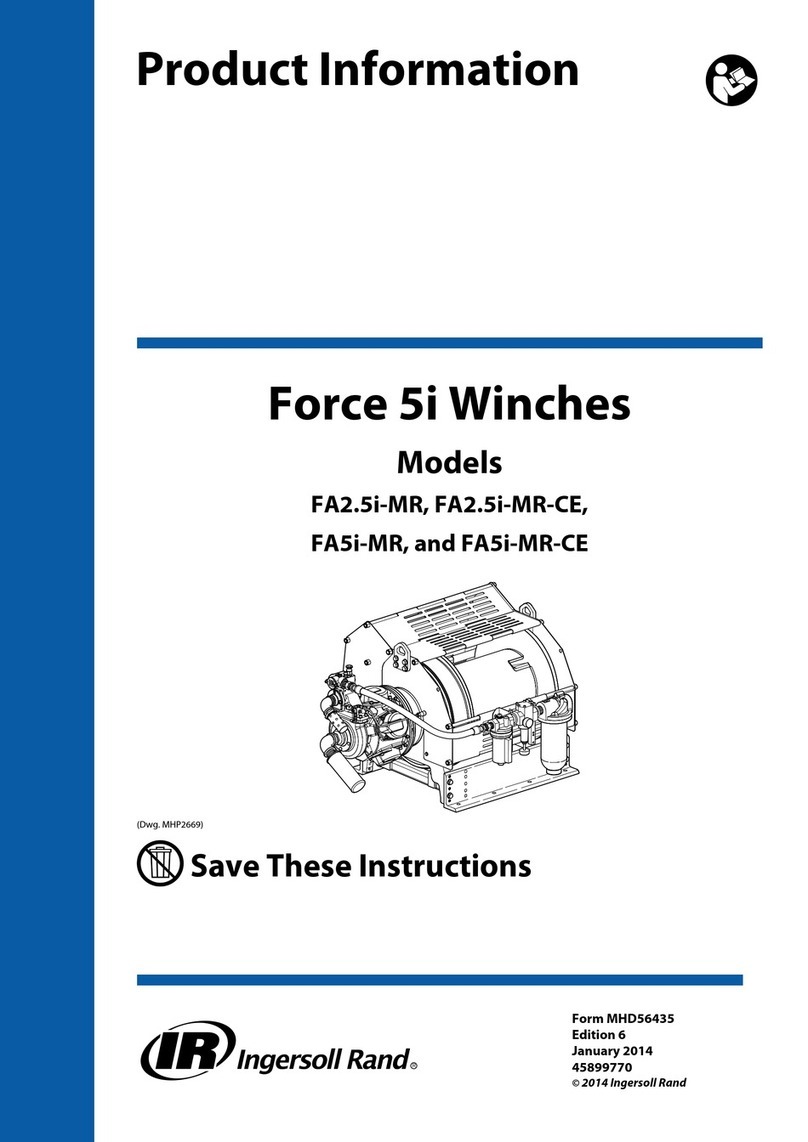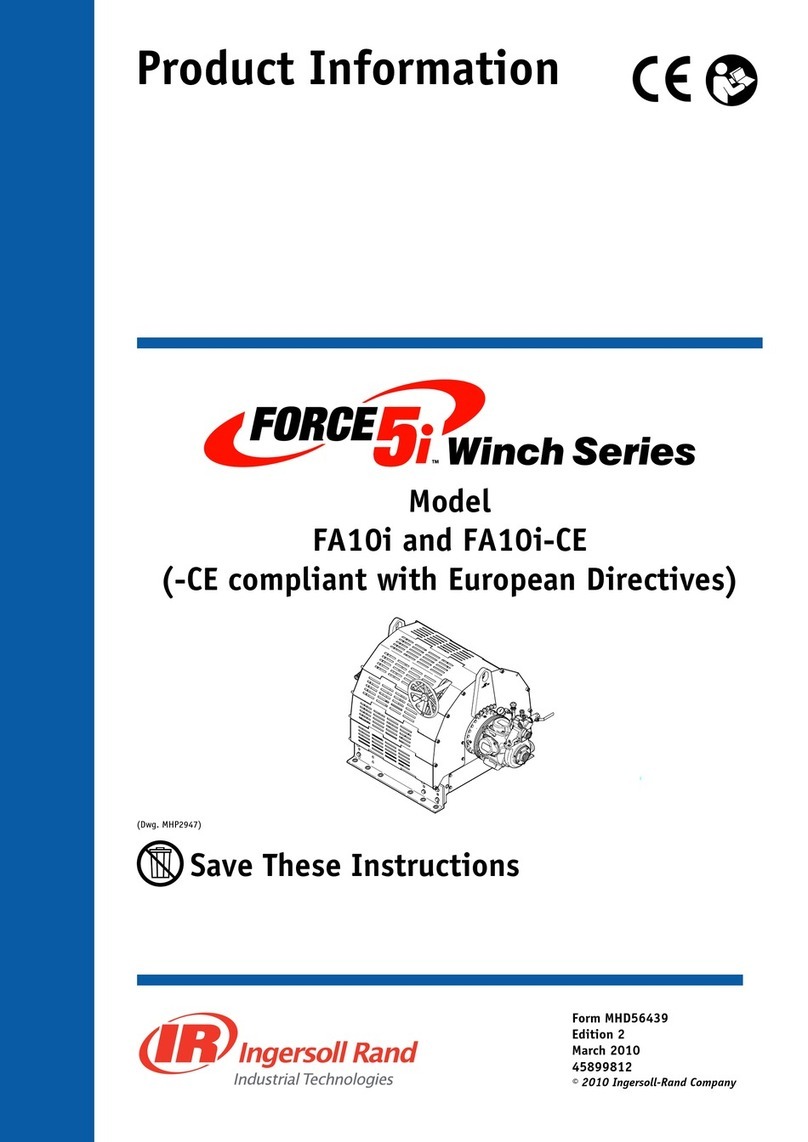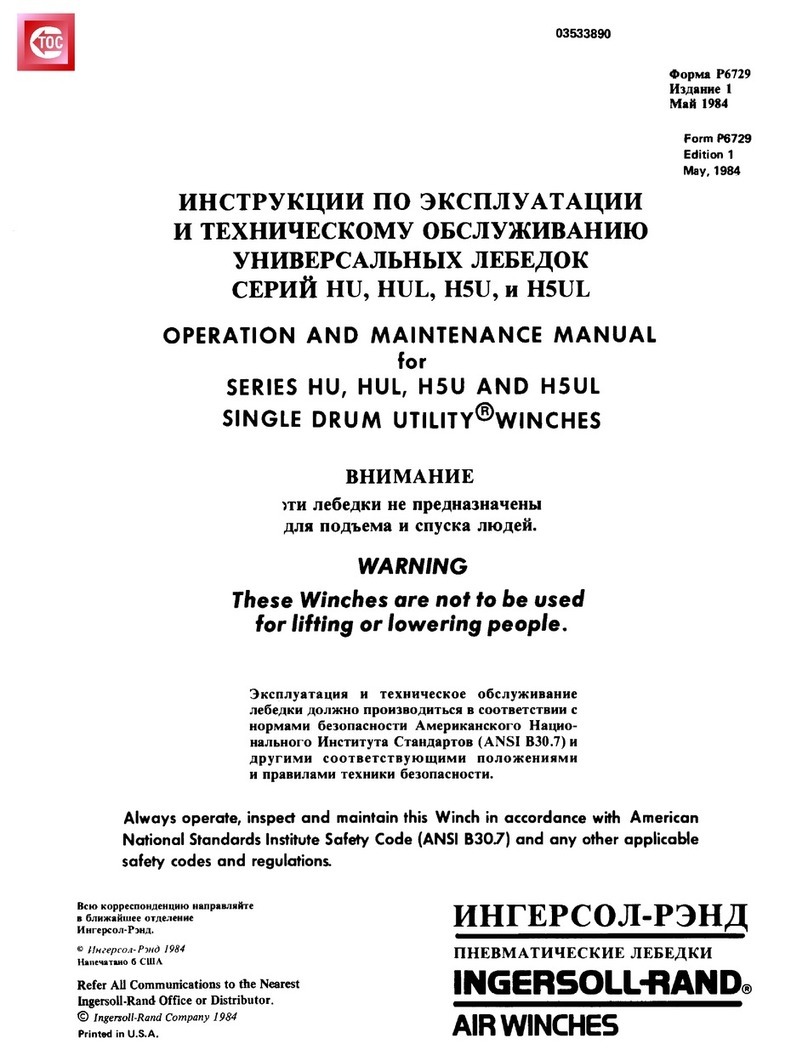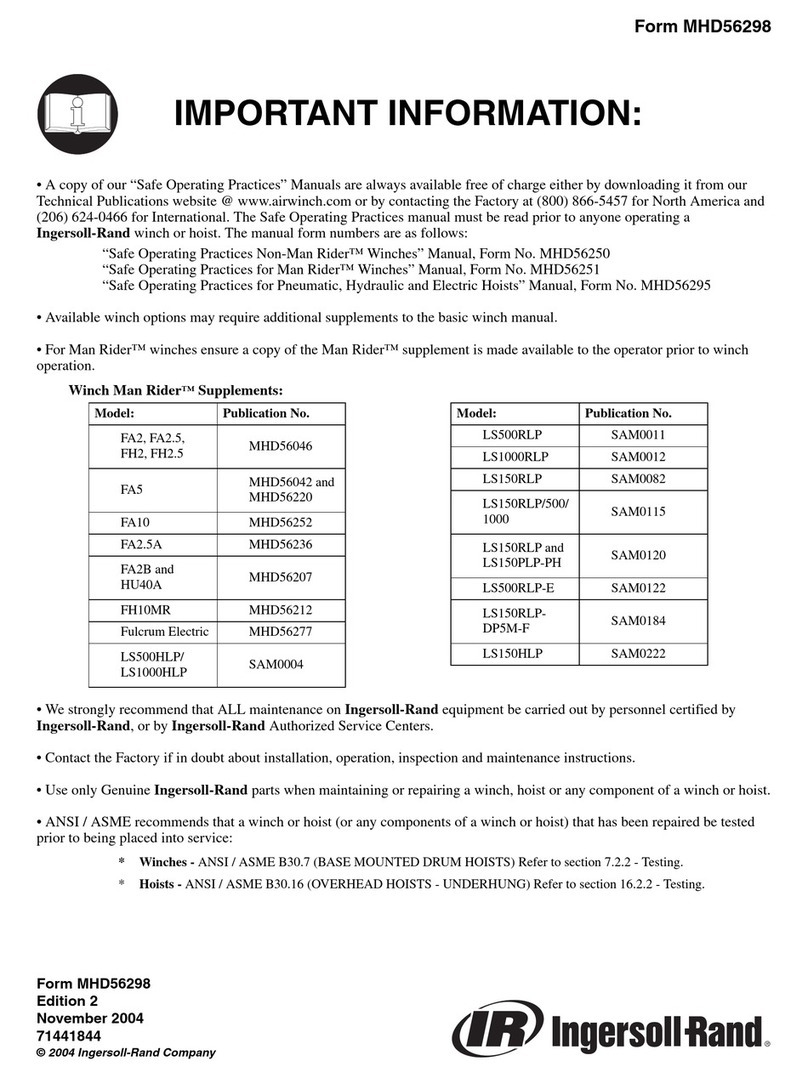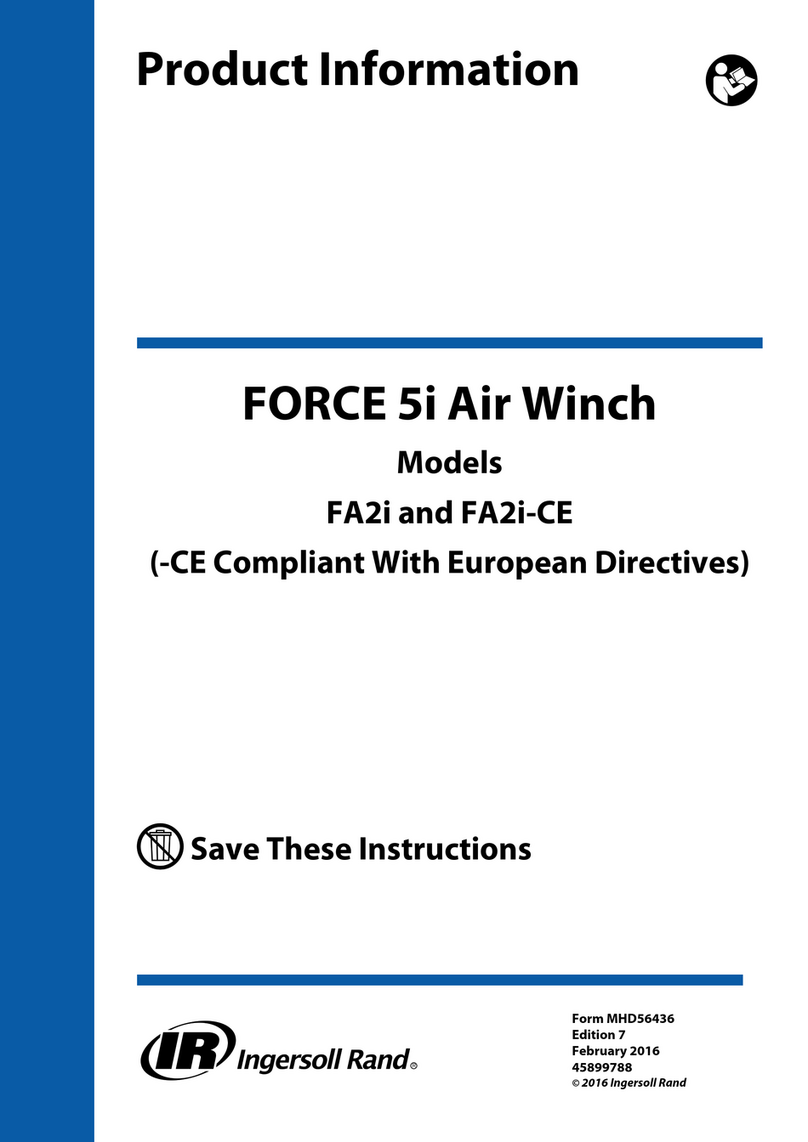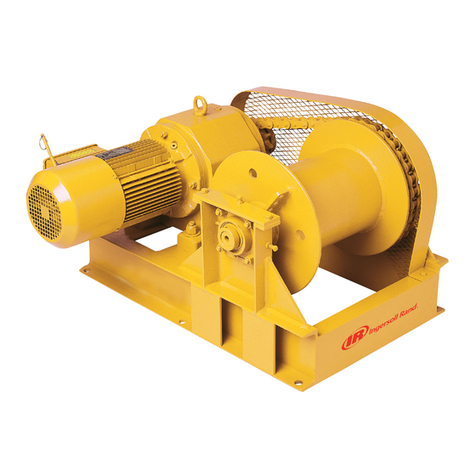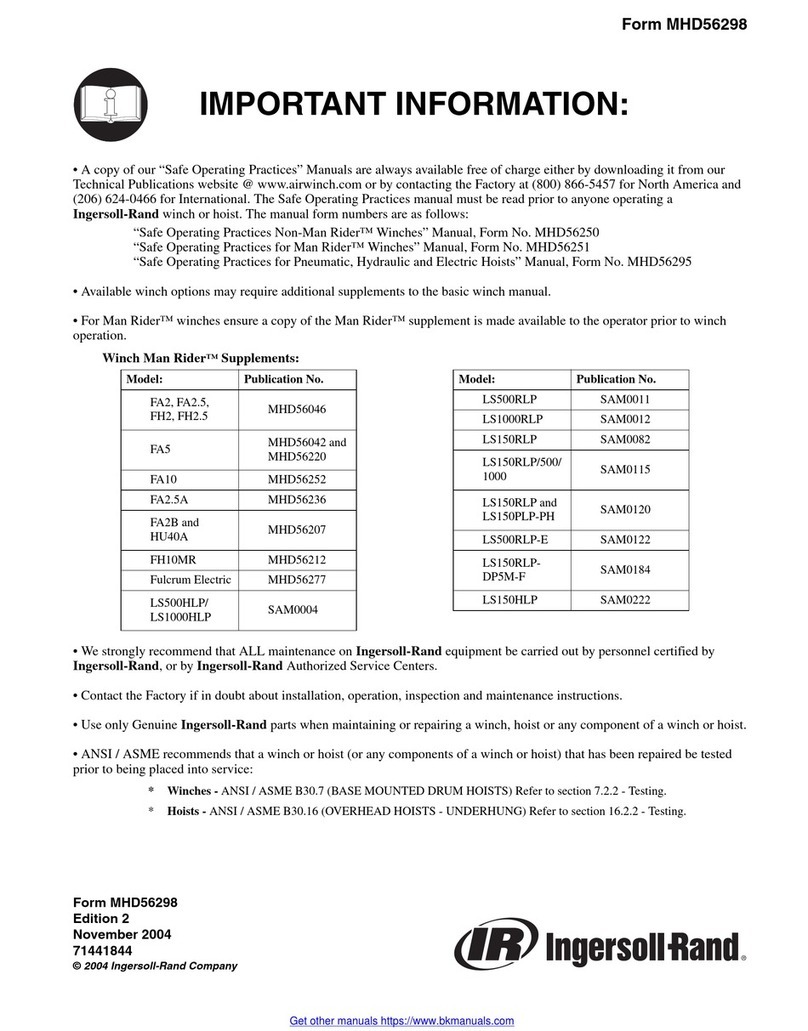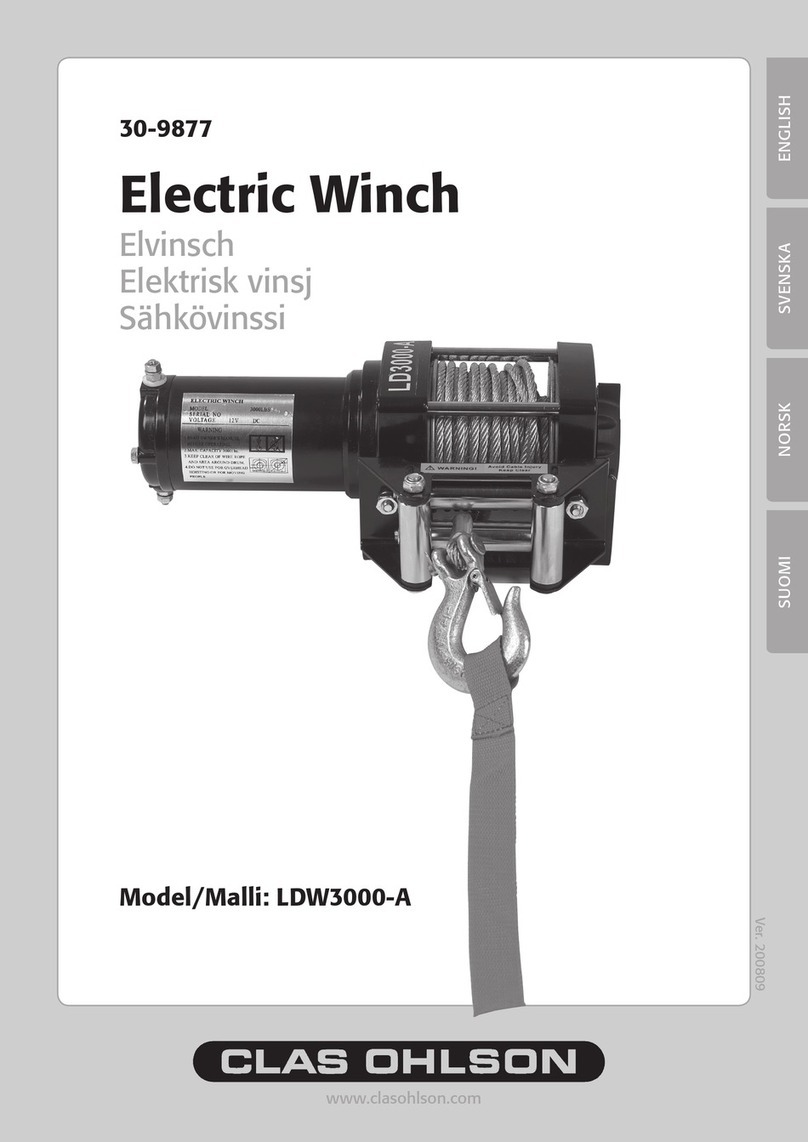
7. Remove capscrews (50) and lockwashers (73). Separate drum end cover
assembly from upright (62).
8. Remove bearing (76) and oil seal (77) from drum (60) if not removed with drum
end cover (78).
9. Carefully turn drum over so limit switch end is up.
10. Remove upright (62) from drum (60).
11. Remove capscrews (50) and lockwashers (73) from drum end cover (78).
12. Remove drum end cover (78) from upright (62).
13. Remove bearing (76) and oil seal (77) from drum (60) if not removed with drum
end cover (78).
nDisc Brake Disassembly
Refer to Dwg. MHP2807.
1. Remove capscrews (25) (black) allowing brake and reducer assembly to be
removed together.
2. Use the two threaded puller holes in the piston (51) to remove piston (51) and
brake reaction plate (57) from brake housing (41).
3. Remove drive plates (56), friction plates (55) and (58), spacer (54) and splined
hub (53). Note position for later assembly.
4. Remove ‘O’ ring (16) and ‘O’ ring (52) from piston (51) and discard.
nReduction Gear Disassembly
Refer to Dwg. MHP2807.
1. Remove disc brake assembly refer to on page 9
2. Remove fill plug (14) and drain oil from reduction gear into a suitable container.
3. Removecapscrews (24)and(25) toseparate reductiongearassembly frombrake
housing (41).
4. Remove capscrews (22) and washers (23) that secure reduction gear end cover
(15).
5. Remove retainer ring (12) from gear shaft (20).
CAUTION
• It may be necessary to use a small amount of air pressure in fill hole of
reduction gear end cover (15) to separate from housing (27).
6. Remove and discard ‘O’ ring (16) on reduction gear end cover (15).
7. It is not necessary to remove bearing (39) from reduction gear end cover (15)
unless damaged. Replace as necessary.
8. Remove bearing (13) and oil seal (17). Replace seal and bearing if necessary.
9. Remove bearing (21) and ring gear (19).
10. Support end cover (15) and tap out shaft (20).
11. Remove retainer ring (36) from sun gear (34).
12. Support reducer housing (27) and gently tap out sun gear (34).
13. Tap out gear shafts (33) and remove planet gears (31), spacers (30), needle
bearings (28) and bearing rings (29).
14. Remove retainer ring (49).
15. Remove sun gear (34).
16. Remove retainer ring (36) and bearing (35).
17. Remove and discard gasket (26) and ‘O’ ring (16) from brake housing (41).
18. Remove and replace bearing (38) if necessary.
nMotor Disassembly
Refer to Dwg. MHP2812.
1. Remove motor assembly as described in ‘Motor and Reduction Gear Removal’
on page 8.
2. Remove control valve assembly (100) from motor assembly.
3. Remove capscrews (103) and emergency stop end cover (185).
4. Remove and discard gasket (101).
5. Remove capscrews (107) and remove motor cover (97) from motor housing (87).
6. Remove and discard ‘O’ rings (90).
7. Remove valves (105) and springs (96) from motor cover (97).
8. Remove ‘O’ rings (94) only if necessary. ‘O’ rings will need to be cut for removal.
NOTICE
• The two bearings (91) located in the motor housing (87) are bonded with
Loctite® 603 or equivalent. Remove idle gear (104) and drive gear (92) only
if replacement is necessary; use a bearing punch (IR pn: 96441232) or
standard drift punch and a hammer. Refer to Dwg. MHP2644
on page 11.
9. To remove both bonded bearings (91) from motor housing (87), it is necessary
to use a bearing punch and hammer. Two or three strikes are enough.
10. If replacement is necessary, remove bearings (91) from drive gear (92) and idle
gear (104) (use a suitable bearing extractor).
11. Remove check valve (83) and ball (84) from motor housing (87).
Emergency Stop End Cover:
1. Remove and discard ‘O’ rings (90).
2. Remove setscrew (180).
3. Remove ball (84).
4. Remove valve seat (186).
5. Remove seal (189) and axle (188).
6. Remove and discard ‘O’ rings (187).
7. Remove spring (193).
8. Unscrew clamping screw (102).
9. Unscrew regulating screw (192) and remove and discard ‘O’ ring (191).
10. Remove valve seat (205).
11. Remove spring (213).
12. Remove capscrews (214).
13. Separate caps (202) and (211), washers (208) and (206), sleeve (209) and
diaphragm (212).
14. Remove seals (203) and (210).
15. Pull stop nut (194) and separate plunger (198) with diaphragm (196) from base
plate (199).
16. Unscrew nut (194) and remove plunger (198) and washer (195).
17. Remove and discard ‘O’ ring (197) .
18. Install a screw (dia. M5) in threaded hole on base plate (199) and pull it from
motor cover (97).
nControl Valve Disassembly
Refer to Dwg. MHP2729.
1. To separate control valve (100) from motor assembly, remove capscrews (137)
and (168) with lockwashers (2).
2. Removecapscrews(118)andlockwashers (2)fromstopplate(119). Removestop
plate.
3. Partially remove capscrew (126) just far enough to allow emergency stop
housing assembly to be removed. Place emergency stop housing assembly to
one side for later disassembly.
4. Remove spools (142) from valve housing (135).
5. Completely remove capscrew (126) and lockwasher (125).
6. Remove lever assembly, coupling (124) and spring (116).
7. Do not disassemble handle unless repairs are needed. To disassemble handle,
tap out pin (120) and unscrew cap (121). Remove handle spool (123) and spring
(130).
8. Remove retainer (140), spindle shaft (131) and gear (138).
9. Remove retainer (140), spindle shaft (131) and gear cam (139).
10. Remove pins (132) from spindle shafts (115).
11. Remove bushings (133) and bushings (141).
Emergency Stop:
Refer to Dwg. MHP2729.
1. Remove emergency stop valve (164) from end cover (172).
2. Remove and discard ‘O’ rings (175).
3. Unscrew and remove valve (165) with ‘O’ ring (171), ‘O’ ring (166) and protector
(170).
4. Remove retainer rings (178).
5. Remove springs (177) and balls (84).
6. Unscrew check valve (83) and remove ball (84).
7. Remove and discard ‘O’ rings (166).
n2 Function Emergency Stop Pendant Disassembly (optional)
Refer to Dwg. MHP2818.
1. Disconnect hoses from pendant assembly (600).
2. Remove fittings (152).
3. Remove lifting eye (617), if necessary.
4. Tap out pin (618) to remove the levers (619).
5. Unscrew and remove check valve (83) and ball (84).
6. Remove setscrew (173) to remove the valve assemblies (165).
7. Remove protector (170), ‘O’ rings (166) and (171) from the valve (165).
8. Remove plugs (623) to remove the springs (177) and balls (84).
9. Remove emergency stop button (164).
10. Remove retainer ring (621) and exhaust washer (615) from handle (622).
nCleaning, Inspection and Repair
Refer to Product Parts Information Manual for item numbers referenced in the
“Cleaning, Inspection and Repair” section.
nCleaning
Cleanall winchcomponent partsin solvent(except drumbrake bandsand discbrake
friction plates). The use of a stiff bristle brush will facilitate removal of accumulated
dirt and sediments on housings, frame and drum. If bushings have been removed it
maybenecessaryto carefully removeoldLoctite®from bushing bores.Dryeachpart
using low pressure, filtered compressed air. Clean drum brake band using a wire
brush or emery cloth. Do not wash drum brake band in solvent. If drum brake band
lining is oil soaked, it must be replaced.
nInspection
All disassembled parts should be inspected to determine their fitness for continued
use. Pay particular attention to the following:
Inspect gears for
- worn, cracked or broken teeth. Replace if necessary.
Inspect bushings for
•-wear, scoring or galling. Replace if necessary.
Inspect shafts for
•-ridges caused by wear. Replace if necessary.
•-scoring or galling.
Inspect all threaded items for
•-damaged threads. Replace if necessary.
Inspect drum band brake lining for
•-oil, grease and glazing. If drum band brake lining is oil-soaked, excessively
greasy or overly glazed, replace brake band. Remove small glazed areas of
band brake lining by sanding lightly with a fine grit emery cloth.
•-thickness of drum band brake lining. If drum brake band lining is less than
0.062 in. (2 mm) thick anywhere along the edges, replace brake band
assembly.
Inspect motor housing gear bores for
•-wear or scoring. For any large scratches or uneven/excessive wear patterns,
replace motor housing.
Inspect motor gears (92) and (104) for
•-ridges or excessive grooving on outside diameter of gears.
•-contact between gears and gear housing.
Inspect press roller and slack wire device for
•-wear, grooves or scoring of rollers. Replace if any of these conditions exist.
•-smooth rotation. Rollers must operate without binding and without
excessive side-to-side play.
Form MHD56305 Edition 4 9


